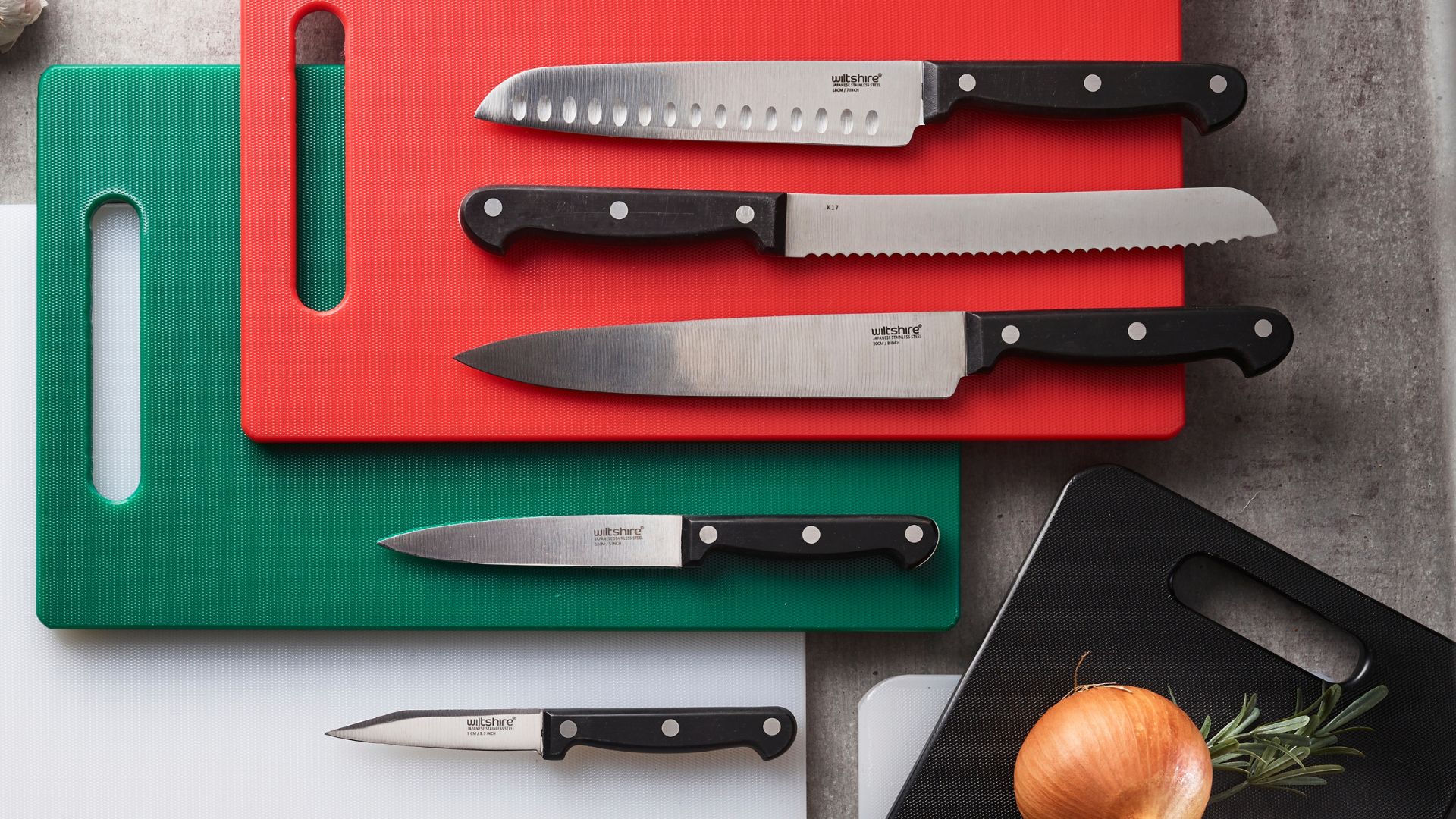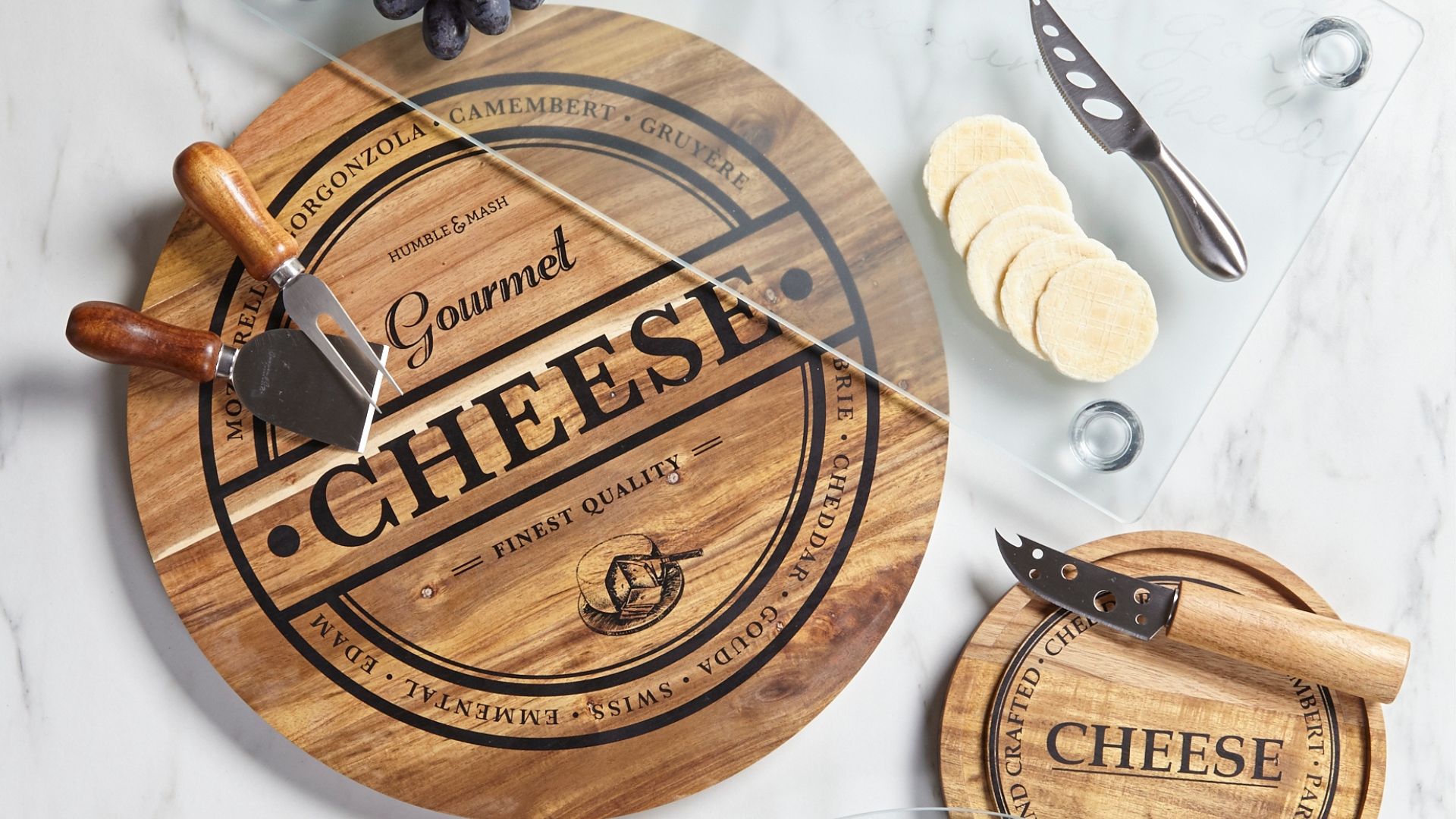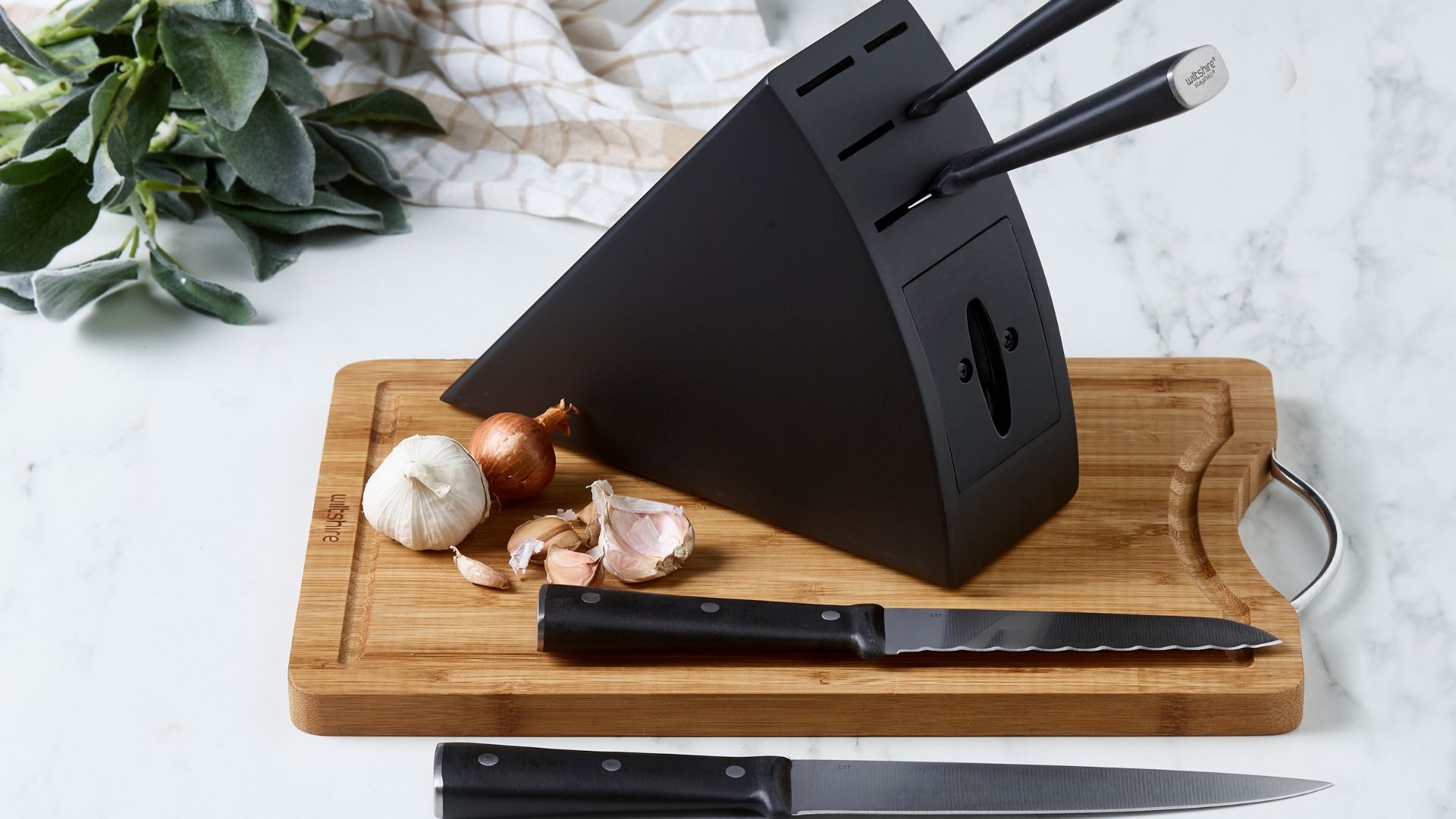 | ||
| Your browser is not supported. | ||
|
Please browse our site using any of the following options:
| ||

Ultimate Guide To Kitchen Knives and How to Choose The Right Kitchen Knife
Possibly the most essential tool when it comes to preparing your meals, kitchen knives allow you to slice, dice, mince and carve your food with little effort and in practically no time at all. The humble cook's knife can function alone as your solo knife, but for a much easier and more effective cooking experience, it's important to have the right knife for the job. There's practically a knife out there for every occasion, which makes finding the right one a bit of a headache when you're not an expert. Wondering 'well, what kitchen knives should I buy then?' Here at Spotlight we've got a huge selection of single kitchen knives and kitchen knife collections, and to help you choose the right one we've created this handy buying guide. Read on to discover everything you need to know about choosing and caring for your kitchen knives, to help make deciding which kitchen knives you should buy easy!
Quick Links
What Are the Main Types of Kitchen Knives And How Should I Use Them?
Let's break down all our favourite kitchen knives and how you can use them in your cooking. In terms of material, many agree that the best kitchen knives are made from high-carbon stainless steel, thanks to their strength, flexibility and resistance to rust. Stainless steel is also a good option, as it isn't as prone to rust as other materials and is durable enough to last you a long time.
All-purpose knives
These knives are the all-rounders, the jack of all trades and the must-haves of this list. It's worth splurging for a good quality knife here, as you'll be using them a lot!
- Chef's/cook's knife- this large kitchen knife has a wide blade that tapers up to a point with a slight curve at the edge of the blade that makes mincing and dicing quick and easy. It often has a full or at least partial tang, to give the knife some extra durability because of its frequent use. (the tang is the metal stripe of the knife that extends into the handle)
- Santoku knife - a Santoku knife is a smaller and lighter version of a chef's knife, with a straight blade instead of a curved one. It can be used for anything, but is better suited to slicing vegetables and less suited to cutting meat than a chef's knife.
- Utility knife - this little knife is light and easy to handle. While it won't slice through large portions of meat or thick vegetables as easily as a Santoku or chef's knife, it can trim, slice and fillet delicate meats and veggies much better than large kitchen knives.
- Kitchen shears/scissors - kitchen shears look like a large pair of scissors and can be used in the place of a knife for cutting herbs, seafood, pita bread and other flat ingredients. If you dread slicing up spring onion for dinner, kitchen shears will make the job easy!
Fruit & vegetable knives
These useful knives will make peeling and cutting fruit and veg to the perfect size easy. They are usually small and easy to manipulate.
- Peeling knife - quickly peel fruit and veggies with a dedicated peeling knife. They work much like your commercial peeler but can be sharpened to maintain their edge, which makes them last longer than a regular peeler.
- Paring knife - these handy knives come with a different type of pointed tip to facilitate particular techniques. Paring knives are commonly used for trimming, peeling and cutting precise pieces of food, and are ideal for slicing off that perfect garnish for your drink.
Meat knives
Carve roasts, debone fish and slice any protein with the right meat knife. It's important to keep these knives sharp so they cut through the meat (and sometimes bone) cleanly.
- Meat cleaver - featuring a thick handle, full tang and the iconic rectangular blade, the meat cleaver can be used to quickly cut through thick sections of meat and bone with a single chop. It also makes chopping up thick slices of pumpkin and squash much easier! Use the flat of the blade to crush large amounts of garlic and ginger.
- Steak knife - you'll see these knives come out whenever you're serving a meal featuring a piece of meat or fish. They are a small, straight kitchen knife with a serrated blade that makes cutting through proteins much easier than it would be with a regular dinner knife.
- Boning knife - this delicate knife can help you cleanly cut meat from bone, and is also very useful when it comes to carefully filleting fish. They have a thin, curved blade that should be stiff - a stiffer blade makes it easier to make precise cuts.
Speciality knives
You'll never know you need these knives until you come to the occasion where you just can't get the same result with your cook's knife.
- Cheese knife - these small, rounded knives are ideal for parties where a cheese or charcuterie board is featured. Cheese knives can cut through thick, creamy blocks of cheese cleanly, creating the perfect-sized slice to pop on a cracker or biscuit. Cheese knives often have decorative handles, to help make your cheese board more visually attractive.
- Bread knife - long and thin, the wide but sharp serrations of a bread knife make them ideal for cutting through loaves of bread without crushing them. You only need to apply light pressure while slicing, which allows you to hold the bread loosely with your other hand rather than having to compact the bread as you would with a traditional cutting-style knife.
- Tomato knife - anyone who has cut a tomato can tell you how annoying it is, as the insides often spill out no matter how careful you are. A tomato knife has been specially designed for cutting this problematic fruit! It features a thin, sharp serrated blade that cuts through tomato easily, without you having to apply any serious pressure as you work. This helps stop the tomato from squishing and spilling out as you slice.
- Butter knife - small, thin and without serration, a butter knife features a smooth edge that allows you to spread butter, jam and other condiments onto your bread without scraping up crumbs as you go. It also won't make unattractive lines in your butter!
As you can see, there's a knife for every occasion here at Spotlight. You can buy the knives you need individually, or choose a knife pack to get all your basics at once.

Should I Invest In a Knife Block Set?
If you're looking to upgrade all your kitchen knives or perhaps you're moving out for the first time and need to get the essentials, a knife block set is a great value way to get all the knives you need to start cooking. Choose from entry level knife blocks with easy to use knives or invest in a quality knife set to really take your knife skills to the next level. A knife block also helps you neatly store your knives away.
How To Sharpen Kitchen Knives At Home
Kitchen knives are easy to clean and dry. You can refer to the Kitchen Knives Care Guide for more tips, but the most important part of their maintenance involves keeping their blades sharp. Knives will slowly blunt the longer you use them, and most people won't notice their knife is blunt due to the slow deterioration of the knife's edge. Cutting with a blunt blade is actually more dangerous than cutting with a sharp one, as it often causes the knife to slip and end up hitting your fingers or the table, as the kitchen knife cannot grab the food it is cutting. And a dull knife will still hurt when it hits your skin!
You may see people 'honing' their kitchen knives with a long metal rod or similar tool. This helps straighten out the blade to help it make smooth cuts, but it doesn't actually sharpen the edge itself.
There are two main ways you can sharpen your knives - using a knife sharpening block or a whetstone. Here is how to sharpen kitchen knives with each:
How to use a knife sharpening block
This is the quickest and easiest way to sharpen your kitchen knife at home. A knife sharpening block will usually have two slots, with one labelled coarse and the other fine. Simply drag the knife blade down through the coarse side a few times, then do the same thing on the fine side.
Knife sharpening blocks are fine to use on most of your kitchen knives, but if you have a more expensive, fancy knife that you really want to take care of, consider using a whetstone to sharpen it instead.
How to use a whetstone
Ever watched a fantasy movie and seen the hero sharpening their sword with what looks like a rock? It's actually a real thing - this rock is called a whetstone, and it's the best way to sharpen your kitchen knives without damaging them - although it's a bit harder to use than a knife sharpening block.Many whetstones are required to be dampened or even fully submerged before use, so make sure to check the instructions on your particular one on how to prepare it for use.
To use a whetstone, hold the knife at a 20-degree angle to the whetstone with the sharp side down. Gently drag the side of the knife against the whetstone a few times, then repeat on the other side of the knife. Like a knife sharpening block, whetstones have a 'coarse' and 'fine' side. Once you are done with the coarse side, flip the stone over and repeat the process on the fine side.
How Do I Store My Kitchen Knives?
Once you've put in the work to clean and sharpen your kitchen knives, it's important to store them properly so they maintain their edge and don't damage your other utensils. There are three main ways you can safely store your kitchen knives:
- A knife block - if you have some space on your kitchen bench and want your kitchen knives within easy reach, a knife block or holder is the obvious choice. Knives can be easily inserted and retrieved from these blocks without blunting the edge of the knife. If you have a knife block with individual slots for each knife, you may need to purchase it in conjunction with a matching kitchen knife set so they fit. Some knife blocks instead feature a mass of flexible bristles you can slide each knife into, which then reform when you retrieve a knife.
- A magnetic knife strip - ideal for when you have little space to store your knives but still want them out in the open, a magnetic knife rack is a stylish way to store and show off your kitchen knives. Make sure the rack you use can adhere to the wall you have in mind, and that there is enough space on it to store all the kitchen knives you need.
- A specialty kitchen knife drawer - if you have enough space in your kitchen drawers, storing your knives in a special drawer insert will keep them safe and out of reach of any kids or pets who might otherwise pull them off your bench. These inserts have thin slots for sliding your kitchen knives into - just make sure you're not jamming them in there, as it may damage the tip of your knife if it is strongly pushed into the back of the insert.

Discover Quality Kitchen Knives At Spotlight
The right knife can make food prep and cooking so much easier - discover the best kitchen knives right here at Spotlight! You can browse the entire range of kitchen knives and shears online, or visit your local Spotlight store and our friendly team will help you find the right kitchen knives for your needs. Discover knives from great brands including Wiltshire, Fiskars and Colormix. For more buying guides to help you in the kitchen, try the Kitchen Tools and Utensils Buying Guide and Kitchen Appliances Buying Guide buying guides.




